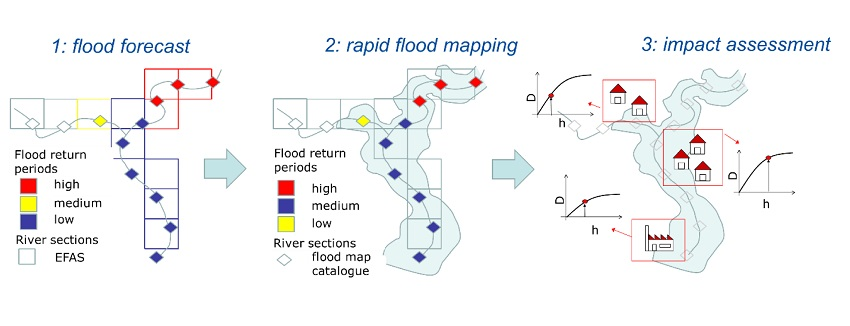GloFAS Rapid Risk Assessment
The rapid risk assessment product aims to provide emergency response actors daily updates of predicted flood
impacts on population, sensitive infrastructures and urban areas. The procedure combines GloFAS flood
forecasts with event-based rapid flood mapping, translating the predicted river flows into explicit flood
inundation maps. The event-based flood inundation maps are combined with exposure information to assess
regional impacts.
GloFAS Rapid Risk Assessment is based on three components: 1) medium-range 15 days flood forecasts, 2)
event-based rapid flood mapping, and 3) impact assessment. The original method to generate these products is
given in Dottori et al.,
2017.

- Medium-range flood forecast: every time a flood event greater than the 10 year return
period is forecasted in GloFAS, the return period of the maximum discharge (based on the ECMWF-ENS
ensemble forecast median) over the 15 days forecast period is computed in each grid cell. These values
do not consider the possible role of local flood defences, therefore they represent an unprotected
scenario. A second scenario which considers flood defences is computed by comparing the forecasted
return period values against estimated flood protection levels from FLOPROS (Scussolini et al., 2016).
River grid cells where the protection levels are exceeded are selected and form the protected scenario.
-
Rapid flood mapping: for each GloFAS river section identified in step 1, flood prone
areas are delineated, using a pre-compiled catalogue of flood inundation maps. The obtained event-based
inundation map has a spatial resolution of 3 arc seconds (approximately 90 m) (up to GloFAS version 3.5,
the resolution was 30 arc seconds, approximately 1 km). This is produced for both the unprotected and
protected scenarios. The unprotected scenario is shown by the “Rapid Flood Mapping” layer on the
Map
viewer. The flood
inundation maps catalogue is generated using the LISFLOOD-FP hydraulic model (CA2D hydraulic model for
GloFAS until version 3).
-
Impact assessment: the event-based flood inundation maps are combined with exposure
information to assess regional impacts (shown on the “Rapid Impact Assessment” layer). Considered
exposure includes population, infrastructure (health, education, airport facilities) and land cover.
Information on potential impact is aggregated over Global administration regions, which are shaded
according to the impact matrix combining the total population exposed to the flood hazard with the lead
time of the flood event.
The CEMS wiki provides detailed technical information on:
